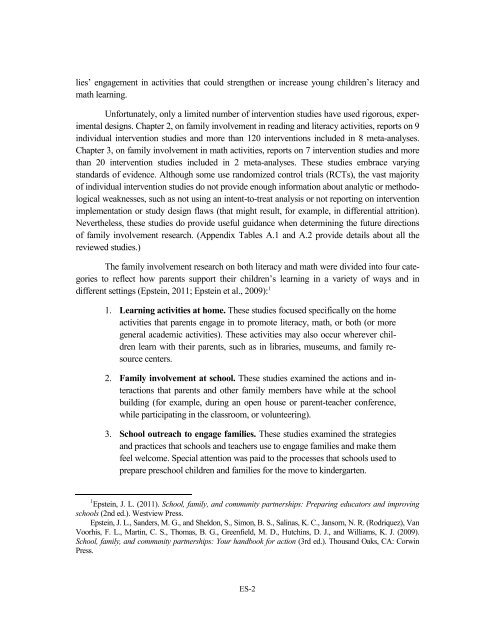u3QtN
u3QtN
u3QtN
Create successful ePaper yourself
Turn your PDF publications into a flip-book with our unique Google optimized e-Paper software.
lies’ engagement in activities that could strengthen or increase young children’s literacy and<br />
math learning.<br />
Unfortunately, only a limited number of intervention studies have used rigorous, experimental<br />
designs. Chapter 2, on family involvement in reading and literacy activities, reports on 9<br />
individual intervention studies and more than 120 interventions included in 8 meta-analyses.<br />
Chapter 3, on family involvement in math activities, reports on 7 intervention studies and more<br />
than 20 intervention studies included in 2 meta-analyses. These studies embrace varying<br />
standards of evidence. Although some use randomized control trials (RCTs), the vast majority<br />
of individual intervention studies do not provide enough information about analytic or methodological<br />
weaknesses, such as not using an intent-to-treat analysis or not reporting on intervention<br />
implementation or study design flaws (that might result, for example, in differential attrition).<br />
Nevertheless, these studies do provide useful guidance when determining the future directions<br />
of family involvement research. (Appendix Tables A.1 and A.2 provide details about all the<br />
reviewed studies.)<br />
The family involvement research on both literacy and math were divided into four categories<br />
to reflect how parents support their children’s learning in a variety of ways and in<br />
different settings (Epstein, 2011; Epstein et al., 2009): 1<br />
1. Learning activities at home. These studies focused specifically on the home<br />
activities that parents engage in to promote literacy, math, or both (or more<br />
general academic activities). These activities may also occur wherever children<br />
learn with their parents, such as in libraries, museums, and family resource<br />
centers.<br />
2. Family involvement at school. These studies examined the actions and interactions<br />
that parents and other family members have while at the school<br />
building (for example, during an open house or parent-teacher conference,<br />
while participating in the classroom, or volunteering).<br />
3. School outreach to engage families. These studies examined the strategies<br />
and practices that schools and teachers use to engage families and make them<br />
feel welcome. Special attention was paid to the processes that schools used to<br />
prepare preschool children and families for the move to kindergarten.<br />
1 Epstein, J. L. (2011). School, family, and community partnerships: Preparing educators and improving<br />
schools (2nd ed.). Westview Press.<br />
Epstein, J. L., Sanders, M. G., and Sheldon, S., Simon, B. S., Salinas, K. C., Jansorn, N. R. (Rodriquez), Van<br />
Voorhis, F. L., Martin, C. S., Thomas, B. G., Greenfield, M. D., Hutchins, D. J., and Williams, K. J. (2009).<br />
School, family, and community partnerships: Your handbook for action (3rd ed.). Thousand Oaks, CA: Corwin<br />
Press.<br />
ES-2


